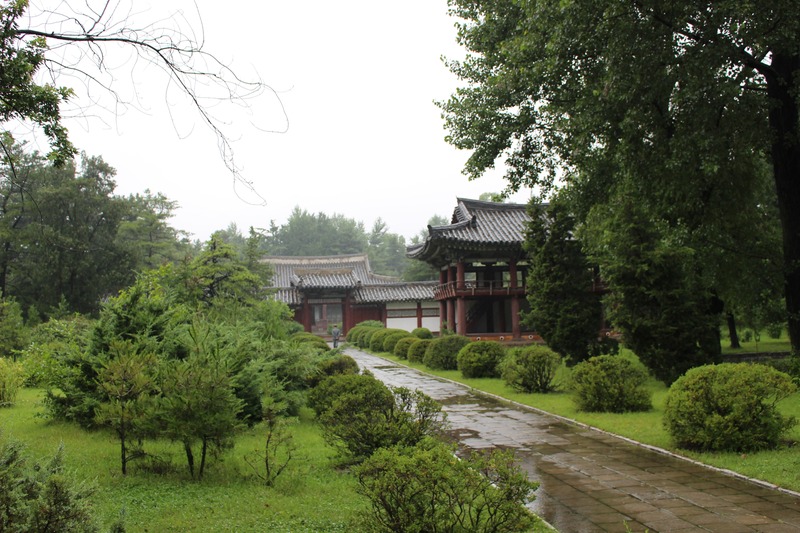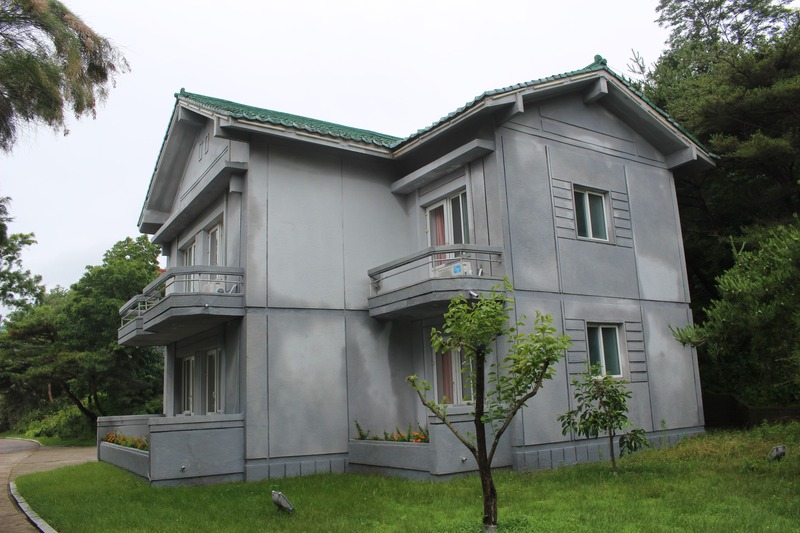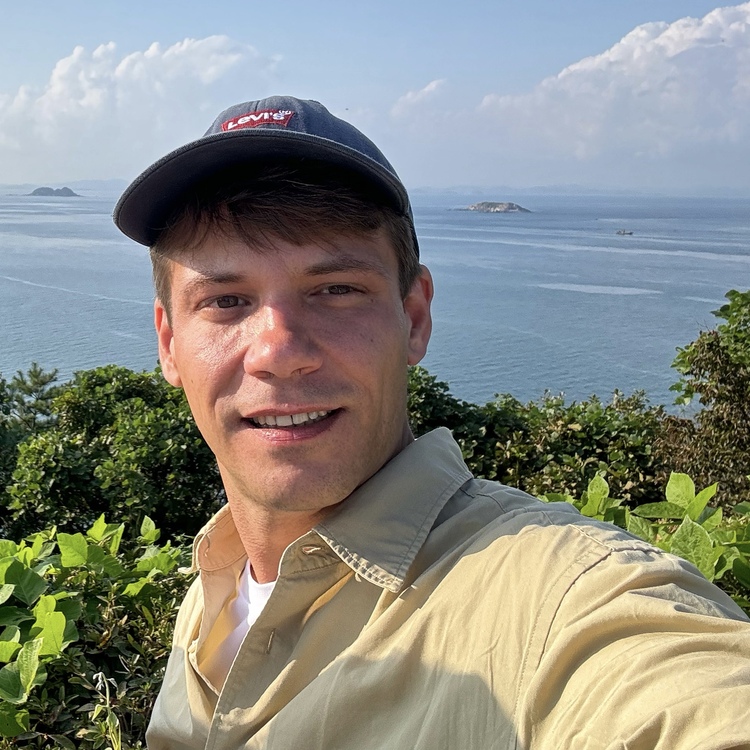From Pyongyang to Hamhung; Sometimes it rained. Sometimes it poured. Luckily, we were stuck in the bus for most of it!
This is a multi-part series where tour leader Greg recounts his first trip to North Korea.
See below for the different parts;
The Rainy Road to Hamhung
We have been quite lucky with the weather throughout our journey.
The weather was not too hot, the air was not too humid, and it was mostly sunny.
Except for this day. Sometimes it rained, sometimes it poured. If it had to happen, however, it was good that it happened that day as we spent around 6 hours on the bus.
Koreans are well prepared for rainy days. In a country where walking or cycling is the most common means of transportation, one has to be. Pyongyang residents and people all around the countryside wore rubber boots and quite a few wore raincoats reminiscent of a hazmat suit.
Our first stop was Lake Sinpyhong, with a rest and guest house for travellers, a shop and a fruit stand. The lake is in the mountains. If we can rely on my poor technical knowledge, there is also a dam on the lake.
The next stop was at the Ullim Waterfall. The waterfall was supposedly discovered in 2001 by the soldiers of the Korean People's Army. Today, a built-in footpath leads to the waterfall, which was almost impossible to photograph due to the weather conditions. We spent our "picnic lunch" here, on the terrace of the guest house.
Our drive continued in the rain through the mountains sometimes on serpentines. Along the road the edge was decorated with small rocks and blooming flowers.
South Hamgyong Province
This province was once part of the greater Hamgyong Province which is now divided into three; South Hamgyong, North Hamgyong, and the Rason Special Economic Zone.
This is a tough place, indeed and as a result, people from here are also characterised as tough. According to Korean regional stereotypes people from Hamgyong Province are like "savage dogs fighting in the mud fields".
Historically, this part of Korea due to its remoteness and harsh terrestrial and weather conditions was a place where those who were not wanted in the centre were exiled to. This is not different even today.
Its provincial capital Hamgung was more harshly hit during the Arduous March in the 1990s than most parts of Korea. Nevertheless, together with Hungam - former South Korean President Mun Jae-in's ancestral hometown - this is the most populous city of the DPRK outside of Pyongyang and is an important industrial centre.
Together with North Hamgyong Province, I found it the least pleasant but on the other hand most interesting region. However, our local partner in Chongjin is one of my dearest colleagues in Korea with his politeness and genuine kindness. And he is a real professional when it comes to guiding.
Tongbong Cooperative Farm
Our first stop here was Tongbong Cooperative Farm. As a former kibbutznik, I was looking forward to this visit with great interest. However, probably due to the poor weather, our visit was cut short and we didn't see much of the farm nor did we learn about the concept of cooperative farms.
First, we stopped at the central square, where there is a convenience store, the community centre, and a concrete-framed picture of the visit of Kim Il Sung and Kim Jong Il.
The shop was quite strange: mostly washbowls, school notebooks, rubber boots, textiles, and matches from the 1950s were on sale. Our tour leader Jessica almost ended up buying a pair of rubber boots.
Then, we drove to an agricultural machinery exhibition. I saw more agricultural machinery in these few square meters than during my entire trip.
I saw one or two working tractors, other than that agriculture predominantly relies on human and animal power.
Actually, in the DPRK everyone is required to do agricultural work.
Even our tour guides are also sent out to the fields.
When I asked one of our guides when their next group was coming or what they were going to do after we left, they also mentioned that they might be sent to do some farm work.
They were certainly not going to have a day off.
Just as the 70-day industrial struggle campaign before the party congress in May ended, another 200-day industrial struggle campaign began. As a result, the six-day work week turned into a "one-day-off work month". Only the first Sunday of each month was a day off.
The work campaign coincided with the introduction of the new Economic Plan. All over the country, you could see white text with the number 200 on a red background on apartment buildings and buses.

Farmers House in the co-operative farm
Visiting a Farm House
We also visited a farmer's house.
The house consisted of two rooms, an entrance hall, a kitchen, and a laundry room. The furnishings were practical and minimalist: a built-in wardrobe, a sideboard, a mirrored wardrobe, a table, a sofa, a TV, and a refrigerator. The walls were decorated with portraits of the leaders, some family photos, and framed birth and marriage certificates.
The house also had a small vegetable garden and a dog.
Apart from the portraits of the leaders, it was not fundamentally different from a house in the Hungarian countryside we frequently visited during my childhood. However, even in the 20th century, some of the farmers' houses would have a portrait of "Our Father Kossuth" the political leader of the Hungarian Revolution and War of Independence against the Habsburgs in 1848/49.
First evening in Hamhung
Our last stop for the day was the Native Home Ri Song Gye. I already mentioned him on the previous day as the founder of the Joseon Dynasty.
It lies on the road between Hamhung proper and Hungnam and it reminded me more of the Confucian "temples" I've been to all over China. Probably not by chance.
The Joseon Dynasty was the longest-ruling Confucian dynasty in Korea with a long-lasting legacy that can be felt even today.

The grounds of Ri Song Gye's Native House
We spent the night at the Majong Beach Guest House. It is a row of smaller guesthouses along the beach.
During our trip, this was the only accommodation where there was no running water at all. The bathtub was filled with cold water, and under the sink, there was a huge bucket of hot water. The bucket was insulated very well because the water was at a pleasant temperature even in the morning.
Our room also had floor heating, which maintained a temperature of about 30 degrees in the room.
Traditional Korean Living
The traditional Korean heating system, called ondol, is genius, by the way.
The kitchen is usually situated a few meters lower than the rest of the house and the heat generated while cooking is channelled under the living quarters of the house. In some regions, the houses have two chimneys so during the summer you can close the route of hot air towards the house.
In other regions, they have outside kitchens to cook during the summer. No surprise that Koreans traditionally sleep and essentially "live" on the floor.
Before entering our building for the night I had a "good-night cigarette" joined by Mr. Ri.
Once again he rubbed it under my nose that the Hungarian People's Republic was the first among socialist countries to establish economic and diplomatic relations with the south and that he still remembers vividly how angry he was because of this act of treason.
Mr. Ri also expressed his hope that I would say good things about the DPRK in China and my home country and that I would tell the truth about his country.
Frankly, at this point, I knew less about North Korea than ever. I was sure, however, that it cannot be reduced to the Manichean narrative, i.e. the dualistic worldview of absolute good and absolute bad.

Our home away from home in Hamhung
